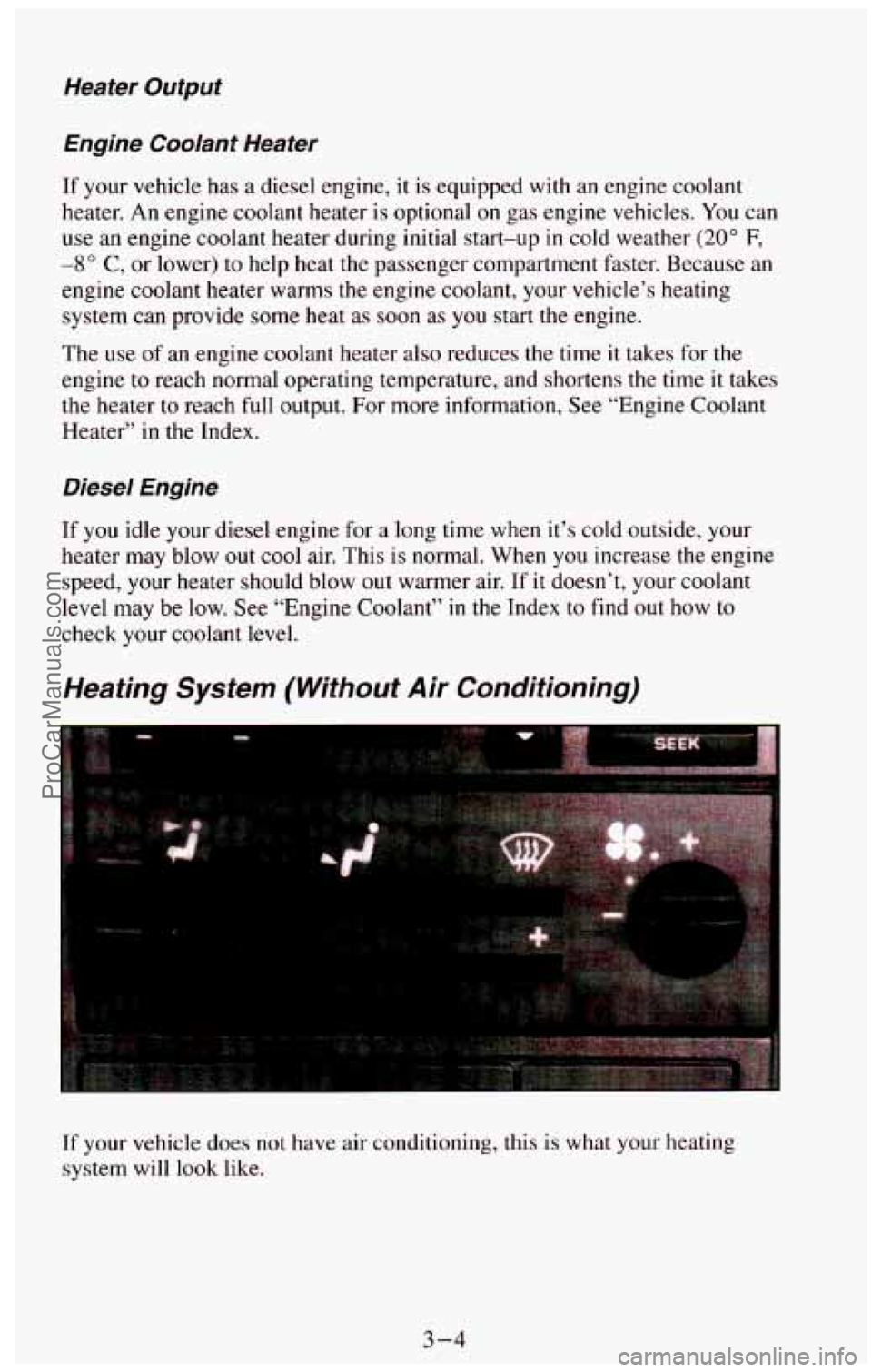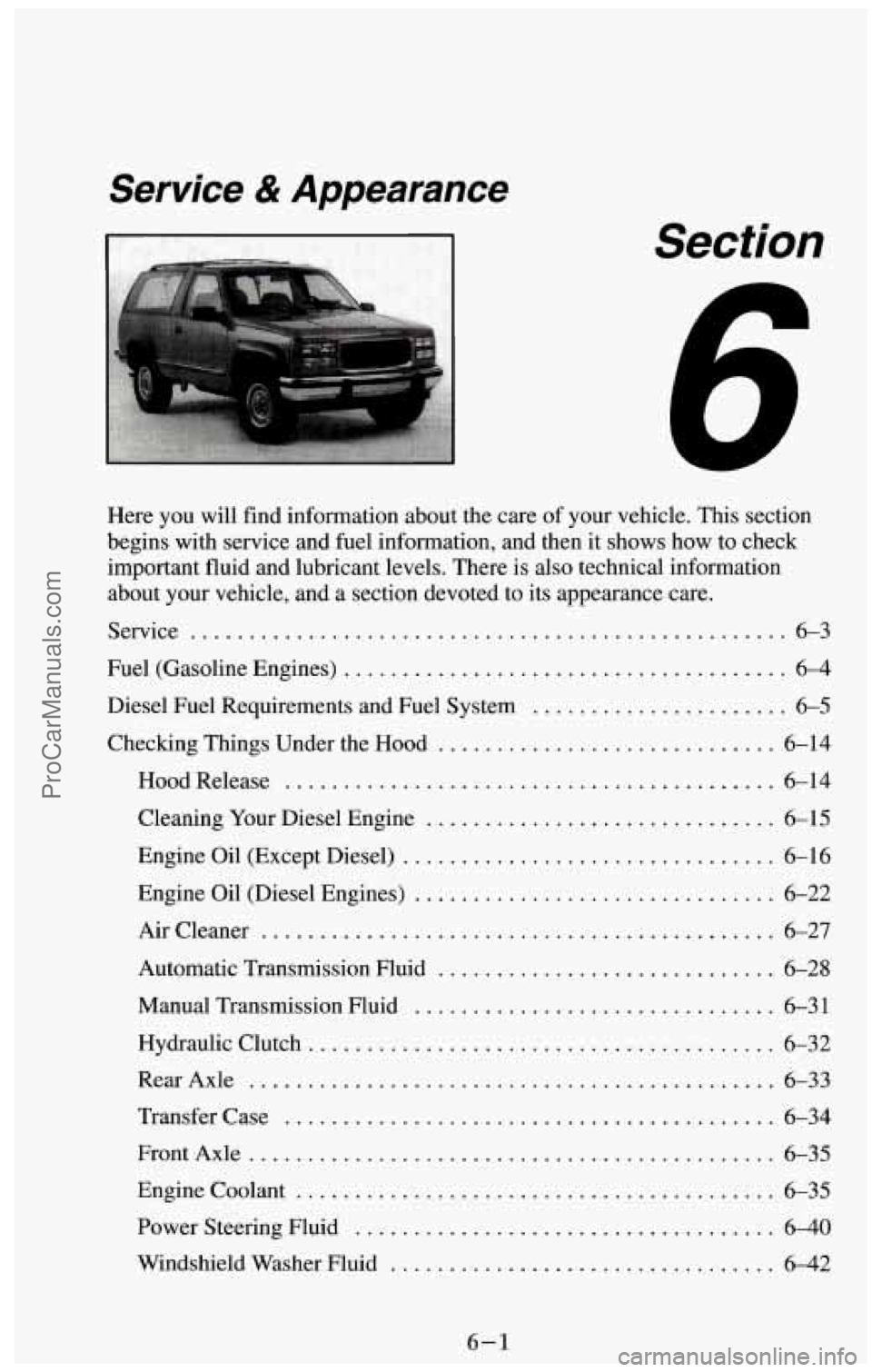Page 141 of 385

Heater Output
Engine Coolant Heater
If your vehicle has a diesel engine, it is equipped with an engine coolant
heater. An engine coolant heater
is optional on gas engine vehicles. You can
use an engine coolant heater during initial start-up
in cold weather (20” F,
-8” C, or lower) to help heat the passenger compartment faster. Because an
engine coolant heater warms the engine coolant, your vehicle’s heating
system can provide some heat as soon as you start the engine.
The use
of an engine coolant heater also reduces the time it takes for the
engine to reach normal operating temperature, and shortens the time it takes
the heater
to reach full output. For more information, See “Engine Coolant
Heater” in the Index.
Diesel Engine
If you idle your diesel engine for a long time when it’s cold outside, your
heater may blow out cool air. This is normal. When you increase the engine
speed, your heater should blow
out warmer air. If it doesn’t, your coolant
level may be low. See “Engine Coolant”
in the Index to find out how to
check your coolant level.
Heating System (Without Air Conditioning)
If your vehicle does not have air conditioning, this is what your heating
system will look like.
3-4
ProCarManuals.com
Page 216 of 385
If the coolant inside the coolant recovery tank is boiling, don’t do anything
else until it cools down.
P
The coolant level
should be at or above
the
COLD mark. If it
isn’t,
you may have a
leak in the radiator
hoses, heater hoses,
radiator, water
pump
or somewhere else in
the cooling system.
NOTICE:
Engine damage from running your engine without coolant isn’t \
covered
by your warranty.
If there seems to be no leak, start the engine again. See if the fan speed
increases
when idle speed is doubled by pushing the accelerator pedal down.
If it doesn’t, your vehicle needs service. Turn off the engine.
5-13 ProCarManuals.com
Page 217 of 385
How to Add Coolant to the Coolant Recovery Tank
If you haven’t found a problem yet, but the coolant level isn’t at or above
the
COLD mark, add a 50/50 mixture of clean water (preferably distilled)
and a proper antifreeze at the coolant recovery tank. (See “Engine Coolant”
in the Index for more information about the proper coolant mix.)
NOTICE:
In cold weather, water can freeze and crack the engine, radiator, \
heater core and other parts.
Use the recommended coolant.
5-14
ProCarManuals.com
Page 221 of 385
6. Start the engine
and let it run until
you can feel the
upper radiator
hose getting hot.
Watch
out for the
engine fan(s).
By this time the coolant level inside the radiator filler neck may be
lower.
If the level is lower, add more of the proper mix through the
filler neck
until the level reaches the base of the filler neck.
8. Then replace the
pressure cap. At
any time during
this procedure
if
coolant begins to
flow out of the
filler neck,
reinstall the
pressure cap. Be
sure the arrows
on pressure cap
line up
like this.
Cooling System -Diesel Engines
When you decide it's
safe
to lift the hood,
here's what
you'll see:
A
A. Coolant surge
tank pressure cap
B. Engine fan(s)
C. Radiator
5-18
ProCarManuals.com
Page 222 of 385
If the coolant inside the coolant surge tank is boiling, don't do anything else
until it cools down.
The coolant level
should be at
or above
the
COLD mark. If it
isn't, you may have
a
leak in the radiator
hoses, heater hoses,
radiator, water
pump
or somewhere else in
the cooling system.
NOTICE:
Engine damage from running your engine without coolant isn't
covered by your warranty.
If there seems to be no leak, start the engifie again. See if the fan speed
increases when idle speed
is doubled by pushing the accelerator pedal down
If
it doesn't, your vehicle needs service. Turn off the engine.
5-19
ProCarManuals.com
Page 223 of 385
How to Add Coolant to the Coolant Surge Tank
If you haven’t found a problem yet, but the coolant level isn’t at the COLD
mark add a 50/50 mixture of clean water (preferably distilled) and a proper
antifreeze
at the coolant surge tank, but be sure the cooling system,
including the coolant surge tank pressure cap,
is cool before you do it. (See
“Engine Coolant”
in the Index for more information about the proper
coolant mix.)
5-20
ProCarManuals.com
Page 226 of 385
While filling the surge tank, watch to see if coolant begins to stream out
the air bleed valve. When coolant begins to stream out, close the valve.
5. With the air bleed
valve closed and
the coolant surge
tank pressure cap
off, start the
engine and let
it
run until you can
feel
the upper
radiator hose
getting hot.
Watch out for the
engine fan(
s).
6. By this time, the coolant level inside the coolant surge tank may be
lower.
If the level is lower, add more of the proper mix to the coolant
surge tank until the level reaches the
COLD mark.
7. Then replace the
pressure cap.
Be
sure the arrows
on the pressure
cap line up like
this.
5-23
ProCarManuals.com
Page 246 of 385

Service & Appearance
I Section
Here you will find information about the care of your vehicle . This section
begins with service and fuel information. and then it shows how to check
important fluid and lubricant levels
. There is also technical information
about your vehicle. and a section devoted to its appearance care
.
Service ................................................... 6-3
Fuel (Gasoline Engines)
............................
Diesel Fuel Requirements and Fuel System ..........
Checking Things Under the Hood ........... .....
........ 6-4
.......... 6-5
......... 6-14
HoodRelease
.......................................... 6-14
Cleaning Your Diesel Engine
............................ 6-15
Engine Oil (Except Diesel)
................................ 6-16
Engine Oil (Diesel Engines)
............................... 6-22
Aircleaner
.................... .................. 6-27 ..
Automatic Transmission Fluid ............................. 6-28
Manual Transmission Fluid
............................... 6-31
Hydraulic Clutch
........................................ 6-32
RearAxle
............................................. 6-33
Transfer Case
.......................................... 6-34
FrontAxle
........................................... 6-35
Engine Coolant
......................................... 6-35
Power Steering Fluid
.............. .................. 640
Windshield Washer Fluid
............................... 6-42
6-1
ProCarManuals.com